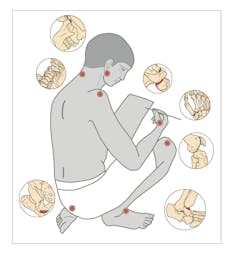Tens of thousands of years ago, during a period of Egyptian history known as the Old Kingdom (around 2649–2130 BC), it was rare for people to be able to read and write. From an estimated population of between 1 million and 1.5 million, only about 1% were literate and able to write in hieroglyphics.
Their rare skills meant that scribes were highly valued by society and the state, and were members of the privileged classes. This can be seen in examples from the ancient Egyptian literary genre now called teaching. In Duakheti’s Teaching (known as The Satire of the Trades), a father introduces his son to 20 different occupations and says:
For the scribal profession is greater than any profession, there is none like it on earth.
Scribes (always men) recorded the business dealings and revenues of the pharaonic court and the powerful temples administered by the priests. If you’ve seen reliefs or statues from the time, you’ve likely seen a representation of these scribes, usually sitting cross-legged or kneeling as they work. They had no ergonomic chairs, adjustable desks or high-quality writing aids to mitigate these uncomfortable positions. But, in Duakheti’s Teaching, the father makes no mention of the trade’s possible physical toll.
As an anthropologist and an Egyptologist, we wanted to find out how their work affected scribes’ bodies. In a recent study with several colleagues from both disciplines, we studied the skeletal remains of privileged men from the Abusir necropolis in Egypt and found that scribes developed numerous problems compared to other men who lived in the Old Kingdom. They were more likely than others in the study to develop degenerative changes in their skeletons, most commonly osteoarthritis in their jaws, cervical spines and knee joints.
Until now, nobody has focused on how scribes’ occupational habits affected their skeletons, and how that compares to other professional groups. Being able to identify specific skeletal changes and degeneration could also be helpful when researchers are trying to identify whether the remains they’re studying belonged to scribes. There aren’t always situational clues or documents related to remains found at ancient Egyptian burial sites.
Identifying the remains
Abusir, located about 20km south of Cairo, was one of the great cemeteries of the Old Kingdom. Almost 200 tombs dating to that period have been discovered there by archaeological teams from the Czech Institute of Egyptology at Charles University in Prague since the 1960s. The studied remains are now kept in a storeroom at another necropolis, Saqqara.
In ancient Egypt, a person’s social class depended on whether they held a senior position in one of the departments of the state administration or on the rank they had attained in the royal court. Their status also dictated where they were entombed. A tomb’s position in the cemetery, its size, the way it was decorated, the size of the burial chamber, and the materials used for the burial equipment all tell us about an individual’s social status.
Martin Frouz, Archive of the Czech Institute of Egyptology FA CU, Author provided (no reuse)
This knowledge meant that we were able to concentrate our study on the skeletons of privileged men. We focused on well preserved specimens so we could reliably estimate sex and age-at-death, as well as get a good sense of skeletal degeneration. We only evaluated dry bones, not mummies.
Of the 69 sets of remains we studied, 30 belonged to scribes. We know this because of written sources found in their tombs. The ancient Egyptians deemed it important to record people’s positions, careers and ranks in the royal court in their tombs. “Our” scribes, as we fondly think of them, included a vizier (the head of the administration, reporting directly to the pharaoh), as well as a scribe to the king and one who kept records of the royal children.
Problems throughout the body
We found that scribes’ work resulted in a higher incidence of degenerative changes in their skeletons than occurred in the other skeletal remains. The scribes showed signs of osteoarthritis, especially in the jaw joint, cervical spine, right shoulder, right thumb and knee joint. They also had more affected muscle and ligament attachments at the humerus and left hip, as well as a higher incidence of squatting facet on the right ankle; this condition is associated with prolonged squatting.
Read more:
What tracing a tough commute in ancient Egypt reveals about osteoarthritis
The changes found in the lower extremities may be the result of prolonged sitting in a cross-legged or kneeling position.
But the most significant (and perhaps the most painful) changes happened in the upper half of the scribes’ bodies.

Jolana Malátková, Archive of the Czech Institute of Egyptology FA CU, Author provided (no reuse)
In a typical working position, the scribe often wrote without the support of his hands. He would sit on the floor with the head bent forward and the spine flexed. This changed the centre of gravity of the head and put stress on the spine, affecting the cervical spine. It was probably also responsible for the men developing severe osteoarthritis in the jaw joint, since these two parts of the skeleton are functionally very closely linked, as recent clinical studies have shown.
Another of the scribes’ necessary habits also certainly contributed to the extreme overloading of the jaw joint. They used pens made from the spiny rush plant (Juncus rigidus) which they chewed at the end to form a brush-like head and then wrote with. Whenever the brush became worn, they would remove the end again, and chew the next section. They repeated this process frequently.
The consequences of this activity can be similar to today’s regular, excessive, or even constant chewing of gum, which is strongly condemned by many dentists – it can cause temporomandibular joint disease, often leading to dislocation of the joint from the socket.
New era, same old problems
Today, we know a great deal about the physical risks office workers face. Those changes will be evident in their skeletons, if these are studied in the future: cervical strain from bad head posture, likely osteoarthritis of the hand or wrist from excessive use of the mouse, and changes in the sit bones and lumbar spine from too much sitting. But at least they don’t have to chew their pens to keep the ink flowing.



